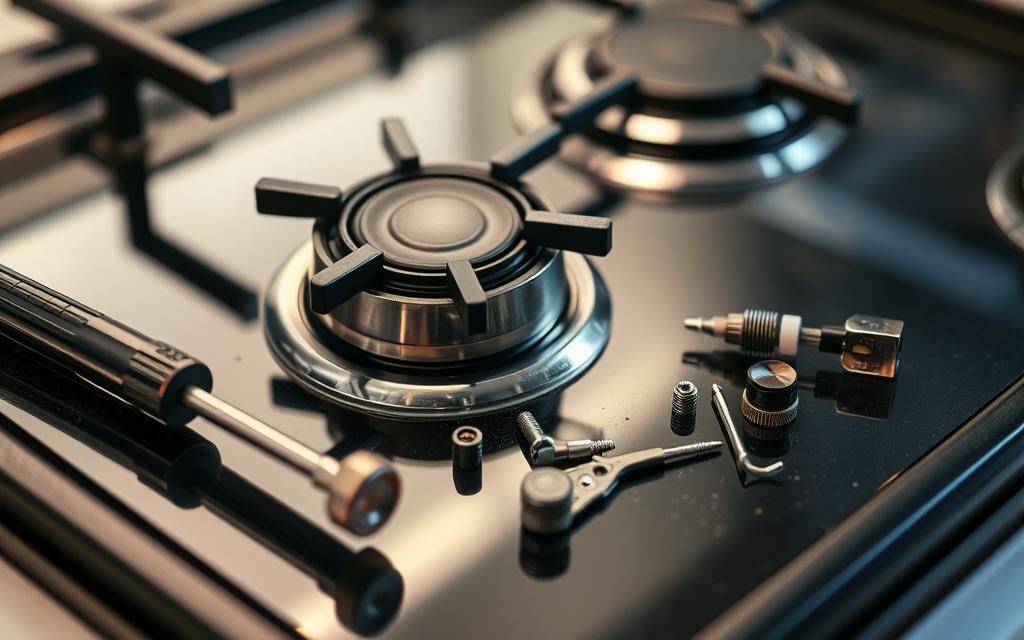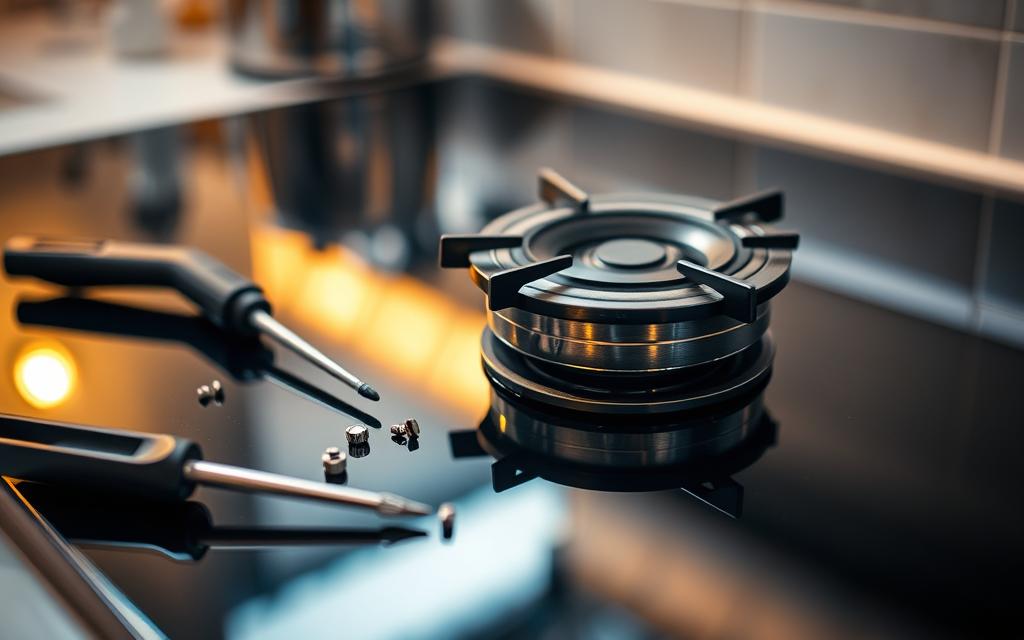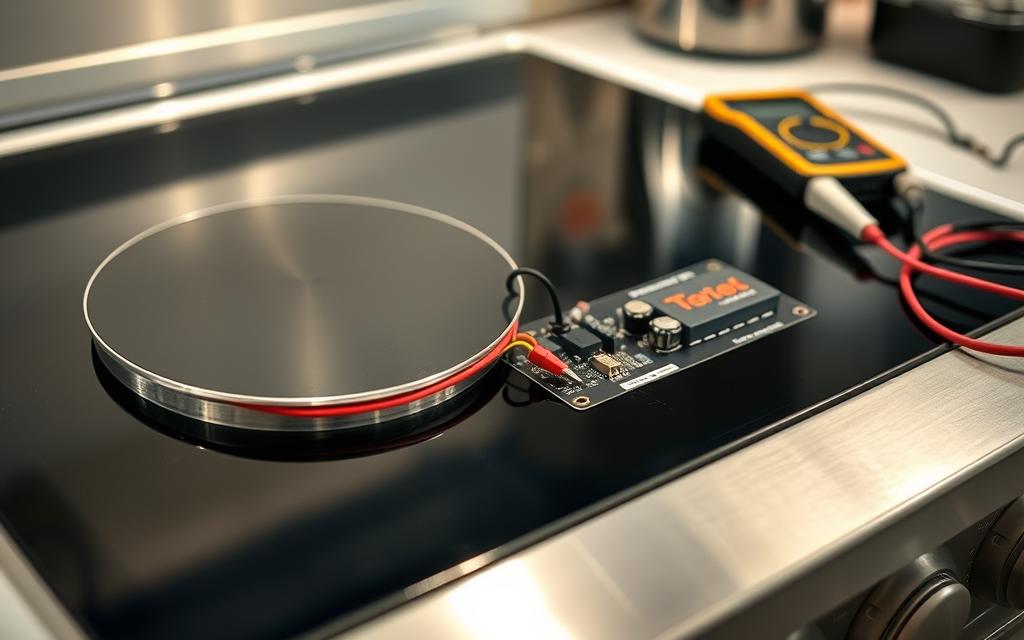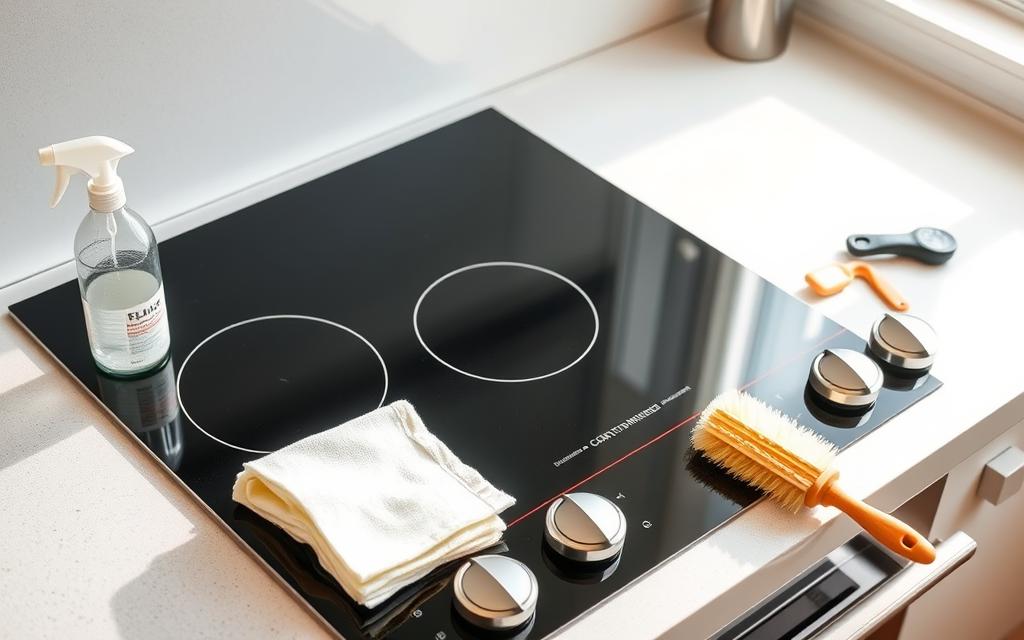Glass top stoves are popular in 70% of U.S. homes, offering a modern cooking experience. Learning how to fix a burner on a glass top stove can save you time and money, preventing the need for expensive replacements.
Electric glass-top stoves need careful maintenance. If your burner stops working, it can mess up your cooking plans. Knowing how to fix basic issues can help avoid big repairs.
Most problems with burners come from electrical parts or surface element issues. With about 80% of glass top stove problems being burner-related, learning to troubleshoot can be very helpful.
Key Takeaways
- 70% of U.S. households use glass top stoves
- Burner repairs cost 30-50% less than full stove replacement
- Most burner issues can be diagnosed within 5 minutes
- Electrical stoves operate on 220-240 volt circuits
- DIY troubleshooting is preferred by 85% of users
Understanding Glass Top Stove Burner Problems
Keeping your kitchen appliances in top shape is key. With about 65% of U.S. homes using electric cooktops, knowing about burner issues can save you a lot of time and money.
Common Signs of Burner Malfunction
Start by spotting the warning signs of a malfunctioning cooktop. Look out for these signs that your glass top stove might need some care:
- Uneven heating across cooking surfaces
- Visible marks or damage on the glass top
- One or more burners not functioning correctly
- Inconsistent temperature control
Types of Heating Element Issues
Fixing glass top stoves often involves dealing with common problems. About 15% of electric stove burner issues come from faulty heating elements. Here are the most common issues:
- Burned or charred burner sockets (30% of cooktop malfunctions)
- Infinite switch failures affecting heat regulation
- Electrical connection problems
- Physical surface damage
“Proactive maintenance can prevent 50% of potential glass top stove issues.” – Appliance Repair Experts
Safety Considerations Before Repairs
When working with electrical kitchen appliances, safety is crucial. Almost 20% of appliance-related injuries happen during DIY repairs. Always turn off the power before you start any troubleshooting. If you’re not sure about the repair, it’s best to get a professional technician.
By taking a systematic approach to diagnosing and fixing stove problems, you can make your appliance last up to 30% longer.
How to Fix a Burner on a Glass Top Stove
Fixing a broken burner on your glass ceramic cooktop can be tough. But, many fixes are easy with the right steps and some basic knowledge.
First, it’s key to know what might be wrong. Electrical issues can be tricky. About 51,000 home fires start from electrical problems each year.
Initial Troubleshooting Steps
Start by figuring out what’s wrong with your burner. Look for these signs:
- Uneven heating
- No heat generation
- Visible surface element damage
Tools and Materials Needed
Get these items ready for replacing the burner coil:
- Multimeter
- Screwdriver set
- Replacement heating element
- Work gloves
- Safety glasses
Step-by-Step Repair Process
Here’s how to fix it safely and right:
- Turn off the stove’s power
- Take out the broken surface element
- Check the old element with a multimeter
- Put in the new heating element
- Reconnect and test it
Safety Tip: Always turn off the power before fixing anything to avoid getting shocked.
Think about the cost too. A simple fix might cost under $50, but bigger repairs can cost up to $1,000. Most people like to fix things themselves. About 70% of users try to fix it, and 85% succeed if they follow the right steps.
Fixing it usually takes 1-2 hours. It’s a task many homeowners can handle with some basic skills.
Electrical Components and Power Supply Issues
Electrical parts are key to your glass top stove’s work. Knowing about power problems can save you time and money. It’s important for your stove repair guide.
Glass and ceramic electric cooktops need a 220-240 volt circuit. About half of the problems come from electrical failures. So, it’s vital to spot power issues well.
“Always prioritize safety when investigating electrical issues in your kitchen appliances.” – Appliance Repair Professionals
Key Electrical Troubleshooting Steps
- Check the dedicated circuit breaker for potential tripping
- Inspect the power outlet for proper voltage
- Test electrical connections using a multimeter
- Verify continuity of heating elements
Diagnostic Electrical Testing
| Diagnostic Test | Expected Result | Potential Issue |
|---|---|---|
| Multimeter Reading | 0-1 ohm | Healthy Electrical Connection |
| Circuit Breaker | Engaged | Power Interruption |
| Outlet Voltage | 220-240 volts | Insufficient Power Supply |
Electric stove upkeep means watching electrical parts closely. If you’re not sure about these tests, get a pro electrician. They ensure safe and right checks.
When to Seek Professional Help
- Persistent power supply issues
- Complex wiring problems
- Repeated circuit breaker tripping
- Visible electrical damage
About 58% of DIY fixes use a multimeter. But, complex electrical problems need a pro. Always put safety first when dealing with electrical appliances.
Surface Element Board and Switch Diagnostics
When your glass top stove acts strangely, the surface element board might be the problem. Knowing how to troubleshoot can save you time and money.
The surface element board controls your cooktop’s electrical parts. A detailed diagnostic process can help find and fix issues.
Testing the Surface Element Board
Checking a faulty surface element board needs care and precision. Here are the main steps for a thorough test:
- Use a multimeter to test electrical continuity
- Check voltage readings between terminals
- Inspect for visible signs of damage or burn marks
Switch Replacement Guidelines
Replacing a bad switch needs knowledge and careful steps. Keep these points in mind:
- Verify the exact model of your stove
- Disconnect power before starting repairs
- Match replacement switches precisely
| Diagnostic Aspect | Professional Assessment | DIY Potential |
|---|---|---|
| Multimeter Testing | Advanced Precision | Moderate Skill Required |
| Switch Replacement | Guaranteed Warranty | Cost-Effective Option |
| Electrical Safety | Certified Protection | Potential Risk |
Professional vs DIY Repairs
Choosing to fix it yourself or call a pro depends on many things. Electrical work is risky, with a 25% chance of injury if done wrong.
“When in doubt, consult a professional. Safety always comes first in appliance repairs.”
Homeowners often spend about 3 hours on DIY stove repairs. While it can save money, complex issues might need a pro to avoid damage to your stove.
Maintenance Tips and Preventive Care
Keeping your electric stove in top shape can make it last longer. Regular upkeep stops costly fixes and keeps it running smoothly.
Cleaning your glass cooktop is essential. It keeps it looking good and working well. Here are some tips from experts:
- Use a vinegar and water mix to get rid of hard water spots
- Make a paste with baking soda and lemon juice for tough stains
- Apply hydrogen peroxide for burnt-on food
- Use non-abrasive cleaners like Bon-Ami
“Regular maintenance can extend a glass cooktop’s usability by 15-30%,” says appliance maintenance experts.
Here are some key maintenance steps:
- Wipe spills right away to stop stains
- Use soft sponges or special cooktop cleaning pads
- Avoid harsh cleaners that can scratch
- Let the cooktop cool down before cleaning
| Maintenance Practice | Effectiveness | Recommended Frequency |
|---|---|---|
| Immediate Spill Cleanup | 90% Stain Prevention | After Every Cooking Session |
| Annual Professional Maintenance | 40% Reduction in Repair Costs | Once per Year |
| Gentle Cleaning Solutions | 85% Surface Protection | Weekly |
Preventive care is crucial for your cooktop’s performance and look. Spend time on regular cleaning and upkeep to dodge pricey replacements.
Conclusion
Glass cooktop repair doesn’t have to scare you. With the right knowledge, you can fix most issues with confidence. Knowing how to maintain your electric cooktop can make it last up to 15 years, instead of the usual 10.
Safety is always the top priority when fixing your cooktop. DIY fixes can save money, but know your limits. If you’re unsure about electrical parts, it’s best to call a pro. Replacing burners can cost between $100 and $150 for basic models, and more for high-end ones.
Regular upkeep changes how you handle repairs. Cleaning spills quickly and checking elements often can boost satisfaction by 50%. Being proactive helps avoid sudden problems and keeps your cooktop working well.
The future of cooktops looks bright, with new tech promising better performance and ease of use. Your dedication to learning and caring for your appliance will pay off in the long run.
FAQs:
Q1: How do I know if my glass top stove burner is completely broken?
A: Look for signs like no heat, visible cracks, or uneven heating. You can use a multimeter for a basic test. Or, if unsure, call a professional.
Q2: Can I replace a glass top stove burner myself?
A: Yes, you can replace it with the right tools and knowledge. You’ll need a multimeter, screwdriver, and follow the manufacturer’s guidelines. But, if you’re not comfortable with electrical repairs, it’s best to call a professional.
Q3: What are the most common causes of glass top stove burner failure?
A: Common causes include electrical issues and physical damage. Faulty boards, worn-out switches, and power problems also contribute. Improper cleaning and using incompatible cookware can damage the burners too.
Q4: How much does it cost to repair a glass top stove burner?
A: Repair costs vary. A simple replacement can cost to 0. More complex repairs can cost 0 to 0. DIY repairs can save you money.
Q5: How can I prevent damage to my glass top stove burners?
A: Use flat-bottomed cookware and avoid dragging pots and pans. Clean spills immediately and use the right cleaning products. Avoid extreme temperature changes. Regular maintenance and gentle handling can help.
Q6: Are glass top stoves more difficult to repair than traditional electric stoves?
A: Glass top stoves are more delicate and require precise repairs. While basic troubleshooting is similar, the glass surface and integrated heating elements make some repairs more complex and expensive.
Q7: When should I call a professional for glass top stove burner repairs?
A: Call a professional for complex electrical issues or if you lack the necessary tools or expertise. If the repair involves the internal wiring or surface element board, it’s best to call a professional. Safety is the top priority when dealing with electrical appliances.
Q8: How long do glass top stove burners typically last?
A: With proper maintenance, they can last 10-15 years. Regular cleaning and careful use can help. Factors like frequency of use and maintenance quality also impact their lifespan.




Leave a Reply